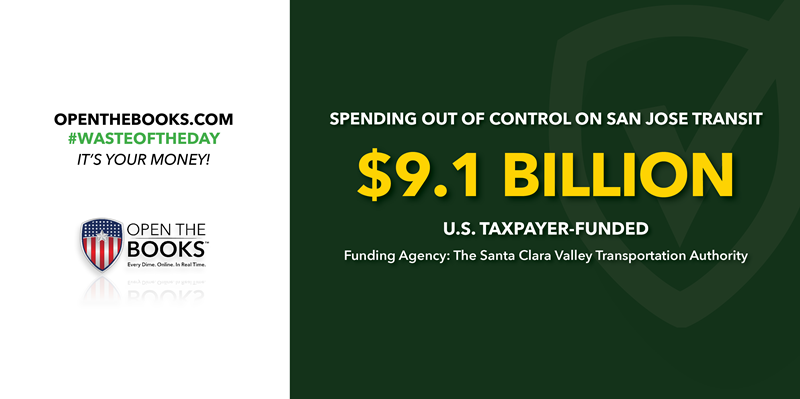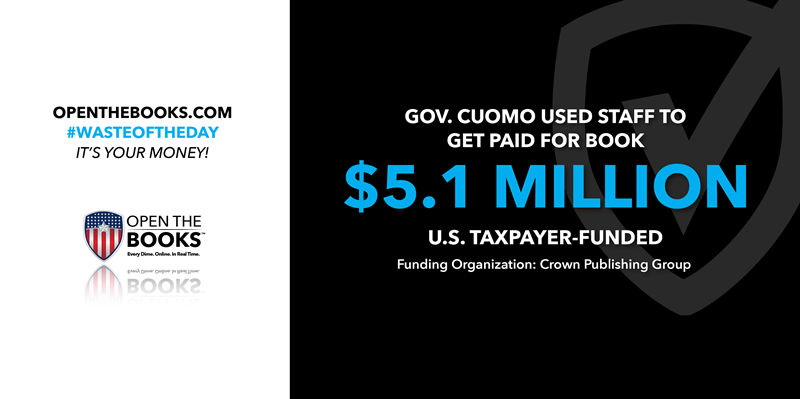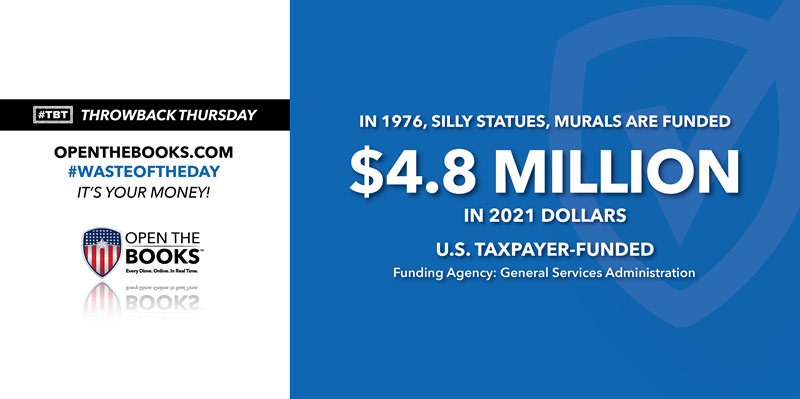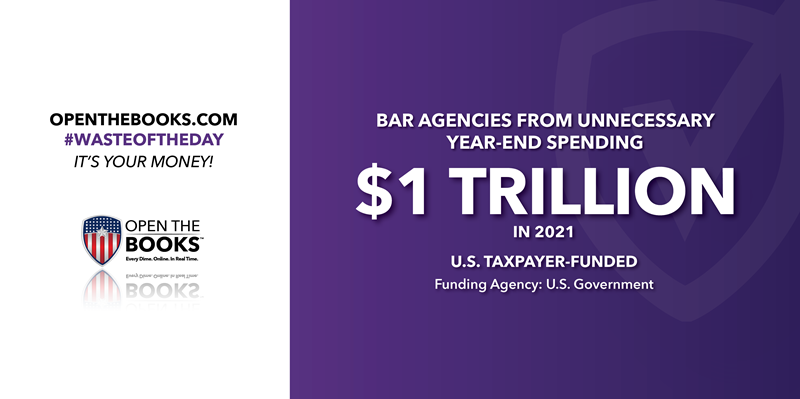
Film Industry Rakes in $1.2 Billion From Federal Contracts
December 6, 2021

While thoughts of the film industry evoke images of the historic Hollywood sign on Mount Lee overlooking the Los Angeles stars below, some film companies have worked with the U.S. government for years, collecting taxpayer money.
Between 2008 and 2021, $1.2 billion in taxpayer money was spent on video production and distribution and other related filming categories, according to our auditors at OpenTheBooks, who looked at federal spending records from that time.
Spending $721 million, the Department of Defense was responsible for most of it, more than the next eight agencies combined. NASA spent $124 million, and the Department of the Interior spent $75 million, respectively.
Of that $75 million in Interior spending, $2.6 million went to Primeridian Entertainment for 29 projects since 2008.
While the international production company based in Beverly Hills may be better known for flicks like “A Hologram for the King” (2016) starring Tom Hanks and “99 Homes” (2015) starring Andrew Garfield, Michael Shannon and Laura Dern, the company designed and produced exhibits at the Fishing Bridge Visitor Center and Trailside Museum at Yellowstone National Park.
They also provided “multimedia services … for informing the public on the National Science Foundation’s role in the nation’s scientific enterprise.”
The hourly rate for one digital video recording job was $282.62 ($565,000 annually), while surround sound mixing cost $214.11 hourly ($428,000 annually).
A senior graphics/motion designer cost $154.16 each hour ($310,000 annually), and an installer made $136.02 hourly ($272,000 annually), the exhibit designer collected $115.87 an hour, web development and engineering was $100.76 hourly and an unspecified consultant collected $91.37 an hour.
While $2.6 million isn’t much in the context of the $1.2 billion in taxpayer money spent, one hopes the visitors to Yellowstone National Park find the exhibits worth it.
San Jose Transit Project Almost Doubles in Cost
December 7, 2021

Originally projected to cost $4.7 billion, a six-mile extension to San Jose’s Bay Area Rapid Transit, or BART, now has a price tag of $9.1 billion.
This summer, the project was estimated to cost $6.9 billion but a more recent estimate now lands at almost double the original cost, The Real Deal reported.
In 2019, the Santa Clara Valley Transportation Authority, which is building the extension, said it would cost $4.7 billion and be finished by 2026 but just as the cost has grown, the completion date has been pushed back to 2030.
The Federal Transit Administration said the VTA underestimated how much the six-mile, four-station extension will cost.
The new estimate considers “additional risk and contingencies,” such as increased costs for labor or supplies, federal officials said.
The extension, which will run from East San Jose to Santa Clara, will consist of a 48-foot-wide tunnel that will accommodate two trains.
Proponents have heralded the single-bore technique as minimizing street disruptions by tunneling deeper from underground, as opposed to the traditional dual-bore tunneling method that tears up chunks of road, The Real Deal reported.
But passengers must use longer escalators that reach deeper into stations, and federal officials are urging the VTA and BART to reconsider the plans as too costly.
The last thing this project needs is additional costs, so officials should seriously consider what’s the best way to get the spending under control.
This project was initially highlighted by U.S. Senator Joni Ernst (R-IA) as a billion-dollar boondoggle.
Cuomo Allegedly Used State Resources and Collected $5.1M for Book Deal
December 8, 2021

While the state was shut down at the beginning of the Covid-19 pandemic and 56,000 people eventually died, now-disgraced ex-New York Gov. Andrew Cuomo was writing a book about his leadership.
He landed a $5.1 million book deal with Crown Publishing Group for “American Crisis: Leadership Lessons from the COVID-19 Pandemic.”
At the time, the New York State Joint Commission on Public Ethics gave Cuomo the go-ahead, saying there wasn’t a conflict of interest — a decision they recently rescinded.
While Cuomo says his staff voluntarily worked on the book on their time off, some have said it wasn’t voluntary.
"It was not optional," a former staffer who asked to remain anonymous reportedly told the Times Union newspaper. "It was considered a part of your job.”
The state attorney general is investigating whether Cuomo broke the law and used his aides to work on the book, allegedly using state resources for personal gain.
When Cuomo got permission from the state ethics board, they said it was to be done on “his own time and not on state time,” and “no state property, personnel or other resources” could be used, The Associated Press reported.
That board recently revoked its permission, according to the New York Post.
Now Cuomo, who resigned in disgrace in August over sexual harassment allegations, must reapply for the board’s OK, and if denied, he may have to give back some, if not all, of the $5.1 million to Crown Publishing.
A governor who focuses his efforts on writing a book to earn him millions in the midst of a pandemic that killed 56,000 people certainly doesn’t have his priorities straight at best and at worst, used taxpayer resources to line his pockets.
In 1976, $1M Spent on 15 Statues, Murals, Other Art
December 9, 2021

Throwback Thursday!
How does spending $100,000 in 1976 — $482,000 in 2021 dollars — on an 80-100-foot baseball bat made of red painted steel in the plaza of a federal building in Chicago sound?
That’s one example of how the General Services Administration spent more than $1 million — $4.8 million in 2021 dollars — on 15 statues, murals or works of art at federal buildings under the Art in Architecture program.
It earned the administration a Golden Fleece award from Sen. William Proxmire, a Democrat from Wisconsin, who gave the citation for wasteful and nonsensical spending, eventually handing out 168 such awards between 1975 and 1988.
“I am not awarding the 'Fleece' to GSA because I am opposed to encouraging art," Proxmire said in 1976. “The concept is sound. But the execution leaves a lot to be desired.”
Calling baseball “our national game,” he suggested instead a statue of Babe Ruth, Ernie Banks, or Bill Madlock “would have some merit.”
“But a $100,000 bat paid for by all of America’s taxpayers is a strikeout with the bases loaded,” he said.
Other items funded by the $1 million included a $34,000 modern mural in Wilmington, Delaware; a sculpture for Las Cruces, New Mexico, which looks like the tale of a yellow whale; a steel sculpture in St. Paul, Minnesota for $42,500 which seems to be a rusty piece of farm machinery left out in the field”; a “rather mystifying” $45,000 sculpture for Rochester, New York; and a life-sized representation of a restaurant scene in Buffalo, New York for $60,000.
While the GSA said the works of art are “intended to be an integral part of the total architecture design (of the building) and enhance the building’s environment for the occupants and general public,” Proxmire argued, “I’m sure the American public agrees that this baseball bat does not represent the finest work of art standard.”
Trillions in Taxpayer Money Wasted Due to Year-End Spending Spree
December 10, 2021

Every year, federal agencies see the end of the fiscal year coming and embark on a spending spree to use the last of their congressionally-allocated funding.
While they have no real reason to spend the money, they do so in fear that leaving part of their budget unspent will mean less money from Congress next year.
This “use-it-or-lose-it year-end spending,” happens every year and since 2019, Sen. Joni Ernst, an Iowa Republican and longtime opponent of Washington D.C.’s wasteful spending culture, has proposed capping agency spending for the last two months at the same rate of spending as during the first 10 months.
Had her proposal been implemented this year, at least $1 trillion in taxpayer money could have been saved.
Ernst’s argument is common sense: agencies should spend taxpayer dollars appropriately, and if they don’t need every penny, they should spend less this year and receive less next year.
Instead, agencies see the new fiscal year looming and flush taxpayer money down the drain.
For example, Congress gave the U.S. Department of Health and Human Services $2.8 trillion in fiscal year 2021. HHS spent $1.8 trillion over the first 10 months — an average of $180 billion monthly — and still had $1 trillion left to spend in the final two months.
If capped under Ernst’s plan, the agency could only spend $360 billion more over the final two months and potentially give back $640 billion of taxpayer money.
It’s a solid, common-sense proposal, and one that Democrats and Republicans alike should be able to get behind as a way to benefit the taxpayers they represent.
The #WasteOfTheDay is presented by the forensic auditors at OpenTheBooks.com.